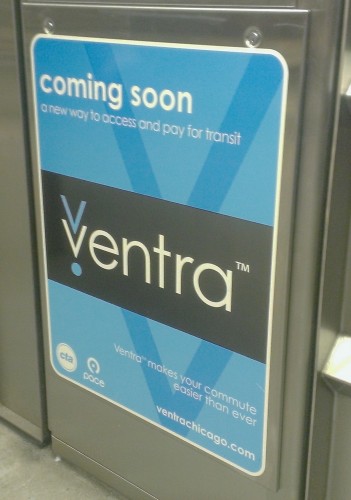But it’ll cost you, and might not work with your phone

If you use the CTA, you’ve seen the boxes appear next to ticket machines at train stations and scanners installed on buses and turnstiles. They call it Ventra, after the Latin word for ‘wind.’ It is the machinery that powers the CTA’s new system for taking fares, coming online this summer. But it’s also the biggest example in Chicago yet of a cutting edge technology that will change the way we pay for things. At first, CTA riders will be able to pay with credit and debit cards if they prefer. But eventually you’ll be able to board a bus or train with just your phone. You won’t need to carry any cards at all.
Current CTA passes use magnets, just like traditional bank cards. But CTA partner Cubic Transportation Systems will no longer make the cards, rendering existing magnetic scanners obsolete. Instead, Ventra scanners deploying on the CTA this year use radio waves to read microchips in plastic and disposable paper cards. This means fare machines will no longer ingest and regurgitate paper cards, but will require just a tap of any card against a scanner, similar to how the magnetic Chicago Cards work. This also allows any contactless bank card, already available from major banks, to pay your fare on the CTA and PACE, with Metra to follow at a later date.
“We’re hoping, eventually down the road, to move away from cash,” says CTA Board Chairman Terry Peterson. The CTA has said it expects to save $50 million by cutting down on fare machine maintenence and electronic processing.
As part of the transition to contactless cards, all special fares and permits, including the U-Pass, will be upgraded to work with Ventra. Limited passes will see a 33% fare hike to $3.00. The reloadable Ventra cards that are replacing the Chicago Card will cost $5, which is immediately converted into a balance usable for fares. The price of a ride on those cards will remain the same as it is now. Buses will continue to accept cash. More information can be found at the Ventra website.
But back to paying for everything with your phone. If, like 129 million other Americans, you own a smartphone, you can use it to replace that wallet or purse full of plastic cards.
Phones can be used for quick transactions in mainly two ways. First, by scanning a barcode or QR code on the phone’s display. Many establishments now use this method; LevelUp lists over 40 merchants in the Loop alone that accept payments via their QR-code based app. Apple’s Passbook app in newer iPhones allows barcode-based ticketing for airlines and at baseball games, among other things. Some public transit agencies like Amtrak and Boston’s MBTA also use this system.
Although paying with a phone offers convenience, code-scanning has a big drawback: it’s not necessarily faster than swiping the old magnetic cards.
But phones also have microchips in them, and this allows them to work the exact same way as a contactless bank card. It’s called near-field communication, or NFC, and many of the newest Android, Windows Phone 8 and Blackberry phones come equipped with it. (Find out if your phone has NFC by checking this list.)
These phones are ready for use at a growing number of locations accepting NFC payments. The Google Wallet Android app allows users to tap and pay at establishments like Macys, Old Navy and Jamba Juice and even some vending machines. Transit agencies in Seoul and London have already adopted NFC for payment. In the United States, the Washington DC Metro and New York City MTA are in the planning stages of doing the same. Philadelphia’s SEPTA, the last major transit system in the USA still accepting tokens, will be upgrading to a system similar to Ventra this year.
Terry Pallenti, a junior at IIT, said he worked on a project to improve the school’s campus cards. “Any time we talked to people, they asked ‘why aren’t you doing it as a phone app?’ or ‘why aren’t you using NFC?’” Pallenti said. Open payments with NFC, he says, could empower students who frequently have to purchase supplies.
Like all new technologies, there are some drawbacks. One big player has yet to embrace NFC technology: Apple. That means millions of existing iPhones won’t work with Ventra scanners. NFC is one of the most commonly-rumored features for upcoming models of the iPhone, but for now, CTA riders that also own America’s bestselling smartphone will have to pay with farecards.
Pallenti says adding NFC capability to IIT’s campus cards was nixed over security concerns, and that contactless cards pose the same risks as magnetic ones. As a larger system, Ventra has safeguards to detect unusual activity and prevent abuse of users’ bank accounts.
But will you risk theft of your phone itself by pulling it out to pay on the CTA? “CTA in 2012 experienced a 16 percent increase in thefts, largely smartphones, mirroring a national trend,” acknowledged the CTA in a statement. “Paying by mobile phone will be fast – requiring a phone to be out of someone’s pocket for just seconds, actually.” Riders concerned about theft may continue to use fare cards instead.
Not everyone can take advantage of the contactless movement yet. “In our culture It seems like everybody really has a smartphone,” observes Pallenti, “but in reality that’s not really the case.” And to use either phones or Ventra cards (developed in partnership with MasterCard) one needs a positive balance in the bank, which will exclude some low-income riders.
Nevertheless, the promise of NFC is more freedom and more flexibility anywhere you spend money. You would be able to to shop for food, gas, and clothes and ride the El all by tapping your phone. And then you could scan a ticket at an airport or Amtrak station, travel to another city, and get around on the transit there by tapping your phone, too.
John Hilkevitch reviews the reactions of Chicagoans to the Ventra card but we think our story will help anyone who thinks the card is confusing, to get a better idea of the changes coming with the advent of Ventra.
Related articles



















Be First to Comment